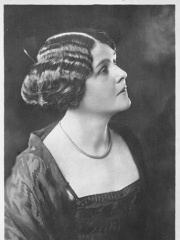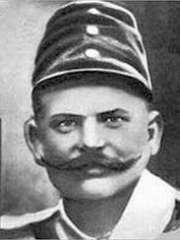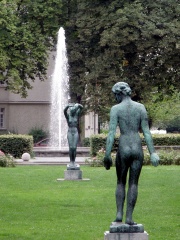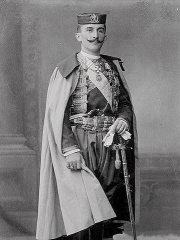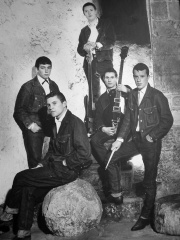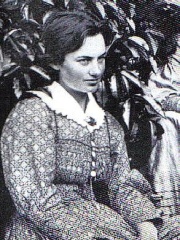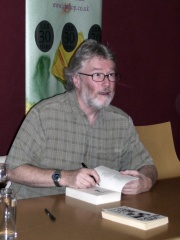WRITER
William Hope Hodgson
1877 - 1918

 William Hope Hodgson
William Hope Hodgson
William Hope Hodgson (15 November 1877 – 19 April 1918) was an English author. He produced a large body of work, consisting of essays, short fiction, and novels, spanning several overlapping genres including horror, fantastic fiction, and science fiction. Hodgson used his experiences at sea to lend authentic detail to his short horror stories, many of which are set on the ocean, including his series of linked tales forming the "Sargasso Sea Stories". His novels, such as The House on the Borderland (1908) and The Night Land (1912), feature more cosmic themes, but several of his novels also focus on horrors associated with the sea. Read more on Wikipedia
His biography is available in 20 different languages on Wikipedia (up from 19 in 2024). William Hope Hodgson is the 3,373rd most popular writer (up from 3,385th in 2024), the 2,717th most popular biography from United Kingdom (down from 2,427th in 2019) and the 308th most popular British Writer.
Memorability Metrics
Page views of William Hope Hodgson by language
Among WRITERS
Among writers, William Hope Hodgson ranks 3,373 out of 7,302. Before him are Erik Gustaf Geijer, Dunash ben Labrat, Alexander Dukhnovych, Daniel Guérin, Bhavabhuti, and Constantine of Preslav. After him are Mikhail Koltsov, Françoise d'Eaubonne, Aino Kallas, Henry Kuttner, Valerius Antias, and Kan Kikuchi.
Most Popular Writers in Wikipedia
Go to all RankingsErik Gustaf Geijer
1783 - 1847
HPI: 59.47
Rank: 3,367
Dunash ben Labrat
920 - 990
HPI: 59.47
Rank: 3,368
Alexander Dukhnovych
1803 - 1865
HPI: 59.47
Rank: 3,369
Daniel Guérin
1904 - 1988
HPI: 59.47
Rank: 3,370
Bhavabhuti
HPI: 59.46
Rank: 3,371
Constantine of Preslav
900 - 1000
HPI: 59.46
Rank: 3,372
William Hope Hodgson
1877 - 1918
HPI: 59.45
Rank: 3,373
Mikhail Koltsov
1898 - 1940
HPI: 59.45
Rank: 3,374
Françoise d'Eaubonne
1920 - 2005
HPI: 59.45
Rank: 3,375
Aino Kallas
1878 - 1956
HPI: 59.45
Rank: 3,376
Henry Kuttner
1915 - 1958
HPI: 59.44
Rank: 3,377
Valerius Antias
200 BC - 100 BC
HPI: 59.44
Rank: 3,378
Kan Kikuchi
1888 - 1948
HPI: 59.44
Rank: 3,379
Contemporaries
Among people born in 1877, William Hope Hodgson ranks 100. Before him are Luke Voyno-Yasenetsky, Titta Ruffo, Béla Kiss, Alphonse de Châteaubriant, Georg Kolbe, and Giuseppe Pizzardo. After him are Edmund Gwenn, Mari Beyleryan, Mordechai Gebirtig, Camillo Caccia Dominioni, Luigi Maglione, and Franz Nopcsa von Felső-Szilvás. Among people deceased in 1918, William Hope Hodgson ranks 114. Before him are Charles Wolf, Malak Hifni Nasif, Ivan Puluj, Prince Mirko of Montenegro, Nigâr Hanım, and Casimir de Candolle. After him are John L. Sullivan, Ulisse Dini, Milan Neralić, Meshadi Azizbekov, Bohumil Kubišta, and Hubert Parry.
Others Born in 1877
Go to all RankingsLuke Voyno-Yasenetsky
PHYSICIAN
1877 - 1961
HPI: 59.74
Rank: 94
Titta Ruffo
SINGER
1877 - 1953
HPI: 59.66
Rank: 95
Béla Kiss
EXTREMIST
1877 - 1915
HPI: 59.59
Rank: 96
Alphonse de Châteaubriant
WRITER
1877 - 1951
HPI: 59.53
Rank: 97
Georg Kolbe
SCULPTOR
1877 - 1947
HPI: 59.46
Rank: 98
Giuseppe Pizzardo
RELIGIOUS FIGURE
1877 - 1970
HPI: 59.46
Rank: 99
William Hope Hodgson
WRITER
1877 - 1918
HPI: 59.45
Rank: 100
Edmund Gwenn
ACTOR
1877 - 1959
HPI: 59.42
Rank: 101
Mari Beyleryan
SOCIAL ACTIVIST
1877 - 1915
HPI: 59.34
Rank: 102
Mordechai Gebirtig
MUSICIAN
1877 - 1942
HPI: 59.31
Rank: 103
Camillo Caccia Dominioni
RELIGIOUS FIGURE
1877 - 1946
HPI: 59.20
Rank: 104
Luigi Maglione
RELIGIOUS FIGURE
1877 - 1944
HPI: 59.18
Rank: 105
Franz Nopcsa von Felső-Szilvás
BIOLOGIST
1877 - 1933
HPI: 59.17
Rank: 106
Others Deceased in 1918
Go to all RankingsCharles Wolf
ASTRONOMER
1827 - 1918
HPI: 60.12
Rank: 108
Malak Hifni Nasif
WRITER
1886 - 1918
HPI: 59.96
Rank: 109
Ivan Puluj
PHYSICIST
1845 - 1918
HPI: 59.80
Rank: 110
Prince Mirko of Montenegro
NOBLEMAN
1879 - 1918
HPI: 59.78
Rank: 111
Nigâr Hanım
WRITER
1856 - 1918
HPI: 59.57
Rank: 112
Casimir de Candolle
BIOLOGIST
1836 - 1918
HPI: 59.55
Rank: 113
William Hope Hodgson
WRITER
1877 - 1918
HPI: 59.45
Rank: 114
John L. Sullivan
BOXER
1858 - 1918
HPI: 59.34
Rank: 115
Ulisse Dini
MATHEMATICIAN
1845 - 1918
HPI: 59.16
Rank: 116
Milan Neralić
POLITICIAN
1875 - 1918
HPI: 59.03
Rank: 117
Meshadi Azizbekov
SOCIAL ACTIVIST
1876 - 1918
HPI: 59.01
Rank: 118
Bohumil Kubišta
PAINTER
1884 - 1918
HPI: 58.98
Rank: 119
Hubert Parry
COMPOSER
1848 - 1918
HPI: 58.87
Rank: 120
In United Kingdom
Among people born in United Kingdom, William Hope Hodgson ranks 2,718 out of 8,785. Before him are Roy Thomas Baker (1946), Joss Ackland (1928), Joe Spence (1898), E. Nesbit (1858), Paul Davies (1946), and Eduardo Paolozzi (1924). After him are Willehad (735), Charles Boycott (1832), Julia McKenzie (1941), John Paul Jones (1747), Alan Price (1942), and Henry Tandey (1891).
Others born in United Kingdom
Go to all RankingsRoy Thomas Baker
MUSICIAN
1946 - 2025
HPI: 59.48
Rank: 2,712
Joss Ackland
ACTOR
1928 - 2023
HPI: 59.48
Rank: 2,713
Joe Spence
SOCCER PLAYER
1898 - 1966
HPI: 59.48
Rank: 2,714
E. Nesbit
WRITER
1858 - 1924
HPI: 59.47
Rank: 2,715
Paul Davies
PHYSICIST
1946 - Present
HPI: 59.47
Rank: 2,716
Eduardo Paolozzi
SCULPTOR
1924 - 2005
HPI: 59.46
Rank: 2,717
William Hope Hodgson
WRITER
1877 - 1918
HPI: 59.45
Rank: 2,718
Willehad
RELIGIOUS FIGURE
735 - 789
HPI: 59.45
Rank: 2,719
Charles Boycott
SOCIAL ACTIVIST
1832 - 1897
HPI: 59.45
Rank: 2,720
Julia McKenzie
ACTOR
1941 - Present
HPI: 59.44
Rank: 2,721
John Paul Jones
MILITARY PERSONNEL
1747 - 1792
HPI: 59.44
Rank: 2,722
Alan Price
MUSICIAN
1942 - Present
HPI: 59.43
Rank: 2,723
Henry Tandey
MILITARY PERSONNEL
1891 - 1977
HPI: 59.43
Rank: 2,724
Among WRITERS In United Kingdom
Among writers born in United Kingdom, William Hope Hodgson ranks 308. Before him are Christopher Robin Milne (1920), Alan Sillitoe (1928), Charles Lamb (1775), Russell T Davies (1963), Ford Madox Ford (1873), and E. Nesbit (1858). After him are Frances Burney (1752), Ephraim Chambers (1680), Prince Henri of Orléans (1867), Edith Durham (1863), Iain Banks (1954), and Marion Chesney (1936).
Christopher Robin Milne
1920 - 1996
HPI: 59.58
Rank: 302
Alan Sillitoe
1928 - 2010
HPI: 59.58
Rank: 303
Charles Lamb
1775 - 1834
HPI: 59.57
Rank: 304
Russell T Davies
1963 - Present
HPI: 59.53
Rank: 305
Ford Madox Ford
1873 - 1939
HPI: 59.49
Rank: 306
E. Nesbit
1858 - 1924
HPI: 59.47
Rank: 307
William Hope Hodgson
1877 - 1918
HPI: 59.45
Rank: 308
Frances Burney
1752 - 1840
HPI: 59.37
Rank: 309
Ephraim Chambers
1680 - 1740
HPI: 59.36
Rank: 310
Prince Henri of Orléans
1867 - 1901
HPI: 59.32
Rank: 311
Edith Durham
1863 - 1944
HPI: 59.29
Rank: 312
Iain Banks
1954 - 2013
HPI: 59.28
Rank: 313
Marion Chesney
1936 - 2019
HPI: 59.26
Rank: 314








